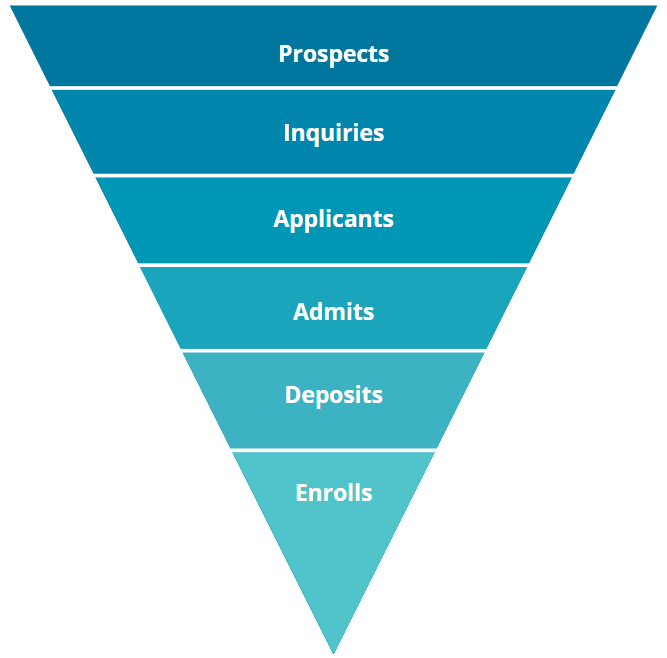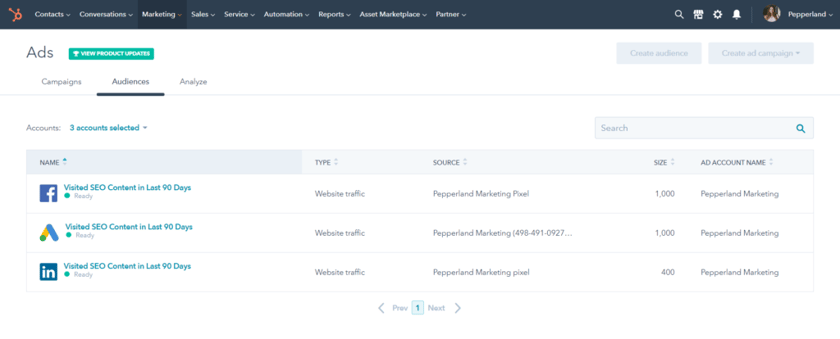Written By:
Kelsey Miller
In this article, we’ll discuss three marketing strategies to increase student enrollment that you might be missing. You will learn:
- How to analyze your enrollment funnel to identify weaknesses and opportunities for improvement
- How to use your blog to provide value to prospects throughout every stage of the funnel
- How to identify stealth applicants earlier in the process
If you’re worried about hitting your enrollment targets or you’ve noticed your usual tactics aren’t performing as well as they used to, chances are it’s time to refresh your marketing strategy.
Some of the tried and true inbound marketing methods for higher education institutions to increase student enrollment include:
- Leveraging marketing automation
- Improving your site’s visibility with SEO
- Optimizing your site for mobile devices
But, there arealso some simple steps you can take to strengthen your strategythat you might be missing. Here are three strategies for increasing student enrollment that marketers shouldn’t overlook.
Free Toolkit – Create Student Personas For Your School
Strategies for Increasing Student Enrollment
1. Analyze your enrollment funnel to find opportunities.
When looking to improve performance and increase applications, one of the first places you should turn is your enrollment funnel. Often, a thorough analysis of your current performance and goals will help you find opportunities for improvement and uncover weaknesses you didn’t know you had.
The enrollment funnel is commonly broken into the following stages: Prospects, inquiries, applicants, admits, deposits, enrolls. Small inefficiencies in any one of these stages can have a significant impact on the number of prospects whoenroll.

Start by analyzing your performance at each stage in the funnel. Are there enough people in each stage to help you reach your goals? Are your conversion rates at a particular stage lower than expected? Thinking critically about where your current performance is falling short will help you narrow in on where to shift your focus.
It’s worth noting that, although the bottom of the funnel typically receives the most attention, the top of the funnel can be just as important. For example, you might already know the number of inquiries you’ll need to receive in order to meet your goal number of applicants, enrolls, and matriculants. But, how many prospects or website visitors do you need to get there? You might find that by growing your website traffic (through organic search, for instance) you’ll be better equipped to meet later stage goals as well.
On the other hand, you may find that you have an impressive number of prospects, but very few of them convert into inquiries. If that’s the case, you may need to shift your focus to lead capturing efforts such as free downloadable content offers, blog subscriptions, and other methods to improve your conversion rates.
2. Think of your blog as a virtual admissions counselor.
Another important step you can take to improve performance is to refine your blog’s content strategy—and if you’re not already blogging, it might be time to consider the benefits!
Think about your blog in the context of the student journey. What role does your content play in helping a potential applicant along the way?
Ideally, your blog should act as somewhat of a virtual admissions counselor and student advisor. In other words, your content should be useful to your prospects by offering them the information that they are actively looking for through the various stages in the process.
At the earliest stages, your blog could serve as a source of information about the careers available with a certain degree, the required skills and experience a person might need to break into that field, and so on. As a potential student navigates forward in their journey, this content should become more aligned with your specific institution, the admissions process, financial aid, and more.
Your blog can be a powerful tool to get more people into your enrollment funnel, especially in the early stages of the journey as mentioned above. But, don’t forget about the role your content can play in retention, as well. In addition to providing support leading up to and throughout the admissions process, your blog can also provide value to enrolled students to keep them engaged with your school.
3. Identify stealth applicants sooner.
Stealth applicants—those whose first recorded interaction with a school is submitting an application—have brought uncertainty to the marketing and admissions teams in recent years. Where did these applicants come from? What channels brought them to the school? What are their pains, challenges, and aspirations
Without any knowledge of who these applicants are, and no indication of their level of interest, the admissions office is left wondering how likely each of these applicants is to actually matriculate, which can quickly lead to inaccurate enrollment projects, budgetary issues, and insufficient resource allocation.
In order to identify and engage these potential students, consider early-stage opportunities to capture their information. For example, downloadable content offers that speak to awareness and consideration stage questions can help you collect the user’s details while also providing valuable information that can ultimately help guide their decision. Simple resources like career guides, tools, and checklists work well.
Once a visitor downloads the offer, you’ll have the information you need to start building rapport and nurture the lead. By the end of that student’s journey, the likelihood of him or her matriculating will be much less of a mystery than if they had become another stealth applicant.
Creating remarketing or retargeting audiences with tools like Hubspot is another effective way to identify prospects before they become stealth applicants. By creating remarketing audiences, you can serve targeted ads to website visitors who left without taking action and encourage them to come back to your site to consume more of your content and eventually become a lead.
Hubspot’s audiences tool allows you to segment your retargeting audiences by different parameters, including the type of content that particular group might be interested in.

For example, you may create audiences for each of the different types of degrees that you support, like business, computer science, etc. If a prospect lands on a blog post about the top computer science careers, you can infer that they might be interested in learning about related topics. If they exit that blog post without taking a specified action, like submitting a form, they’ll be targeted with these ads which will guide them toward your additional resources.
Segmenting your retargeting audiences in this way will allow you to show prospects ads that are valuable to them, making them more likely to come back to your website and ultimately convert.
Another benefit to learning the identity of stealth applicants earlier in the process? Once you have enough information on which channels are actually leading to applicants, it becomes easier to allocate resources to those channels which are working while either scaling back the channels which aren’t, or revamping your efforts in those channels to improve conversions.
Create a Winning Strategy
Hitting your enrollment goals is critical to your college or university’s overall success. If you’ve noticed that your growth has slowed or you’re struggling to hit your targets, it’s important to revisit your enrollment marketing strategy and find opportunities for improvement. In addition to you revamping your usual efforts, don’t overlook impactful steps like identifying gaps in the enrollment funnel, refining your content strategy, and identifying prospects before they become stealth applicants.
To maximize the impact of your marketing efforts, it’s also important to have a clear understanding of your audience throughout every stage of the enrollment funnel. Creating thoughtful, data-backed student personas can help you tailor your content to the specific questions, goals, and needs that will resonate with your ideal applicants. Get started by downloading the free student persona toolkit below.








